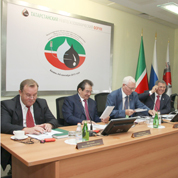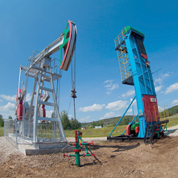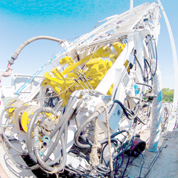Tatneft is fully ready for new challenges in the oil industry
Issue:
October 2013, Vol. 10
Tags:
Tatneft

The experience of Tatneft has shown that a science-based approach to old oil wells drilling has considerable potential, Rustam Minnikhanov, the president of the Republic of Tatarstan said during the celebration of the 70th anniversary of oil production in the region.
According to the president, only the application of new technologies in all the segments of oil industry, backed up with a systematic approach to the development of oil deposits, in conditions of aging fields, has enabled Tatarstan not only to avoid experiencing a decline in production, whilst stabilizing output at a high level, but also to increase oil recovery from old wells. In 2012, the republic produced about 32.7mln tons of "black gold," the highest volume since 1992. Since 1998, the volume of annual oil production in the region had increased by 2mln tons, and, according to experts’ forecasts, Tatarstan can retain this level over the next 30 years.
The prevailing market conditions and new challenges are forcing a serious review of policies in the oil industry, the president noted. In particular, this applies to shale oil production, which has a huge future business potential in the region. This requires a completely new approach and the relevant research works have already started in the region. Tatneft is fully ready for these new challenges in the modern oil industry, evident from the successful application of the oil-layer hydraulic fracturing method, Minnikhanov said. This means a great future for the No.1 oil company in the republic, he added. After all, Tatarstan still has over a billion tons of traditional and up to 7bn tons of high-viscous (bitumen) oil on its territory, he added.
The key priority areas of innovation, according to the president, include launch, active development and drilling of reserves of carbonate collectors, increase in production oil from low permeable reserves, development and introduction of new methods of enhanced oil recovery. All these measures will help access these enormous reserves. The relevant works along these lines have already started, the president noted. In general, in the Tatarstan oil industry, it is necessary to operate in time horizon of 20-30-50 years, have a material resources base and the necessary technologies to ensure the production of various types of oil: light, heavy and bitumen. "Our sciences have to meet these challenges," Minnikhanov noted.
“Tatneft has retained and increased its production of "black gold" thanks to its systemic innovation activities.”
A major role in all these activities, according to the president, belongs to Tatneft. The oil major’s high intellectual potential has enabled it not only to stabilize, but also to increase oil production in the late stages field exploitation. In 2012, Tatneft produced over 26mln tons of oil. And if it were not for its systematic use of modern technologies, the company’s oil output would be half this volume, the president noted. Today, Tatneft’s oil wells represent a polygon for the development of more efficient technologies in all the sectors of the oil industry, be it geology, drilling or major wells repairs and maintenance, he added.
Breakthrough technologies
It is a well-known fact that there had been a noticeable shift in the share of hardly accessible or inaccessible deposits in the structure of Russia’s hydrocarbon reserves. Specifically, this refers to viscous oil and hard-to-reach oil producing wells. These sources offer significant potential for boosting oil production for decades to come.
With the appropriate stimulation, it is possible to increase oil production in the existing oil fields, thanks to new technologies that enhance increasing oil recovery from such difficult locations. Tatneft, which had inherited lots of depleted oil fields in the so-called era of drilling “oil at any price,” has long been dealing with these problems. Retaining these breakthrough positions and maintaining Tatneft’s competitiveness in this industry, according to CEO Shafagat Takhautdinov, will be impossible without the implementation of a sound technical policy.
Tatneft has become a Russian pioneer in such technologically complex area as drilling of viscous oil, whose reserves in the region is enormous. As for shale oil, Tatneft could be rightly said to have risen to this promising resource. All the company’s accumulated knowledge in this field, such as the application of oil-bed layer multi-stage fracturing technology in an extended horizontal bore, will be useful. This method enables Tatneft to significantly increase the filtration area. Tatneft plans to, both literally and figuratively speaking, apply this breakthrough technology, currently being used in the US for shale gas production, for the extraction of shale gas in the region. This year, it has successfully tested the second fleet for undertaking hydraulic fracturing of oil layers.

Tatneft has also set up a center to provide geological support needed to more effectively manage the process of drilling wells with horizontal ends. The center, working in an online regime, uses shaft wiring and high-tech equipment, which allows the company to insert a horizontal hole into the most productive part of wells, and thus, significantly enhance the well’s oil production rate.
In terms of drilling in general, Tatneft has adopted a five-year program of technical re-equipment and modernization of all its oil production facilities. The program envisages providing the drilling teams with modern equipment rigs, top drive systems and more powerful mud pumps, etc. It has also successfully tested an equipment that helps move the drilling units onto special rails. This equipment can significantly shorten the time needed for an oil well construction.
One of the most promising aspects of Tatneft’s activities is the development of wells with a complex architecture. Specifically, this includes splitters drilling of horizontal wells. The division of horizontal shafts into a number of sections allows for controllable drilling of oil from each section. The most sophisticated technology is the construction of multi-shaft wells. With the help of this technology, a lateral shaft is drilled from an existing well into an upper lying zone of exploration. This will give a huge advantage that arises from the possibility of using additional exploration facilities. Today, Tatneft, within the framework of pilot projects, is laying foundation for the construction of such oil wells. It has developed prototypes of equipment, which after undergoing all the relevant field tests, will be finalized and tried in the stands.
Skolkovo’s help
The volume of oil production can be increased in old wells by increasing the so-called oil recovery rate coefficient to 0.6 and above. Simply put, about two-thirds of mineable oil in wells under drilling usually remains as inaccessible leftovers. For Tatneft, this coefficient is usually between 0.4 and 0.5 and growing steadily. But for Tatarstan, this is very important because each percentage point increase means an increment of 10mln tons of oil reserves. This stems from the possibility of drilling oil deposits from the areas that were previously inaccessible due to the lack of relevant technologies.
The defining role in the stabilization of oil production volume belongs to the modern methods of enhanced oil recovery. For example, last year, Tatneft was able to produce almost 5.9mln tons of crude from tertiary oil recovery technologies, accounting for over 22% of the company’s total production.  At present, a significant part of Tatneft’s current oil well reserves is concentrated mainly in carbonate collections, the drilling of which is extremely difficult.
At present, a significant part of Tatneft’s current oil well reserves is concentrated mainly in carbonate collections, the drilling of which is extremely difficult.
 At present, a significant part of Tatneft’s current oil well reserves is concentrated mainly in carbonate collections, the drilling of which is extremely difficult.
At present, a significant part of Tatneft’s current oil well reserves is concentrated mainly in carbonate collections, the drilling of which is extremely difficult.By the way, Tatneft’s two new technologies, which were presented at the Gas and Petrochemicals Forum held in September in Kazan, were each awarded a Grand Prix in their nominations. These include the development and application of acid-stimulating compositions, KSK-Tatneft, and the technology of increasing output from depleted oil reserves by using certain silica gel-based compositions. In general, a wide range of modern methods of enhanced oil recovery developed by the company is being used in other regions of Russia as well as by oil companies in other countries.
To further enhance its scientific and technical activities, Tatneft has registered a Research and Technology Center (RTC) in the Skolkovo Innovation Center outside Moscow. The RTC plans to conduct research in the fields of oil and gas production, exploration, refinery, gas- and petrochemicals, as well as resources preservation and IT. Specifically, this refers to technologies that can be used for so-called “heavy oil” production, development of environmentally friendly projects and more effective methods for intellectual oil fields management.
This text was translated from Russian, edited and copyproofed by The Chrisbon Business Services Agency (www.chrisbon.ru)












 Web design,
Web design,